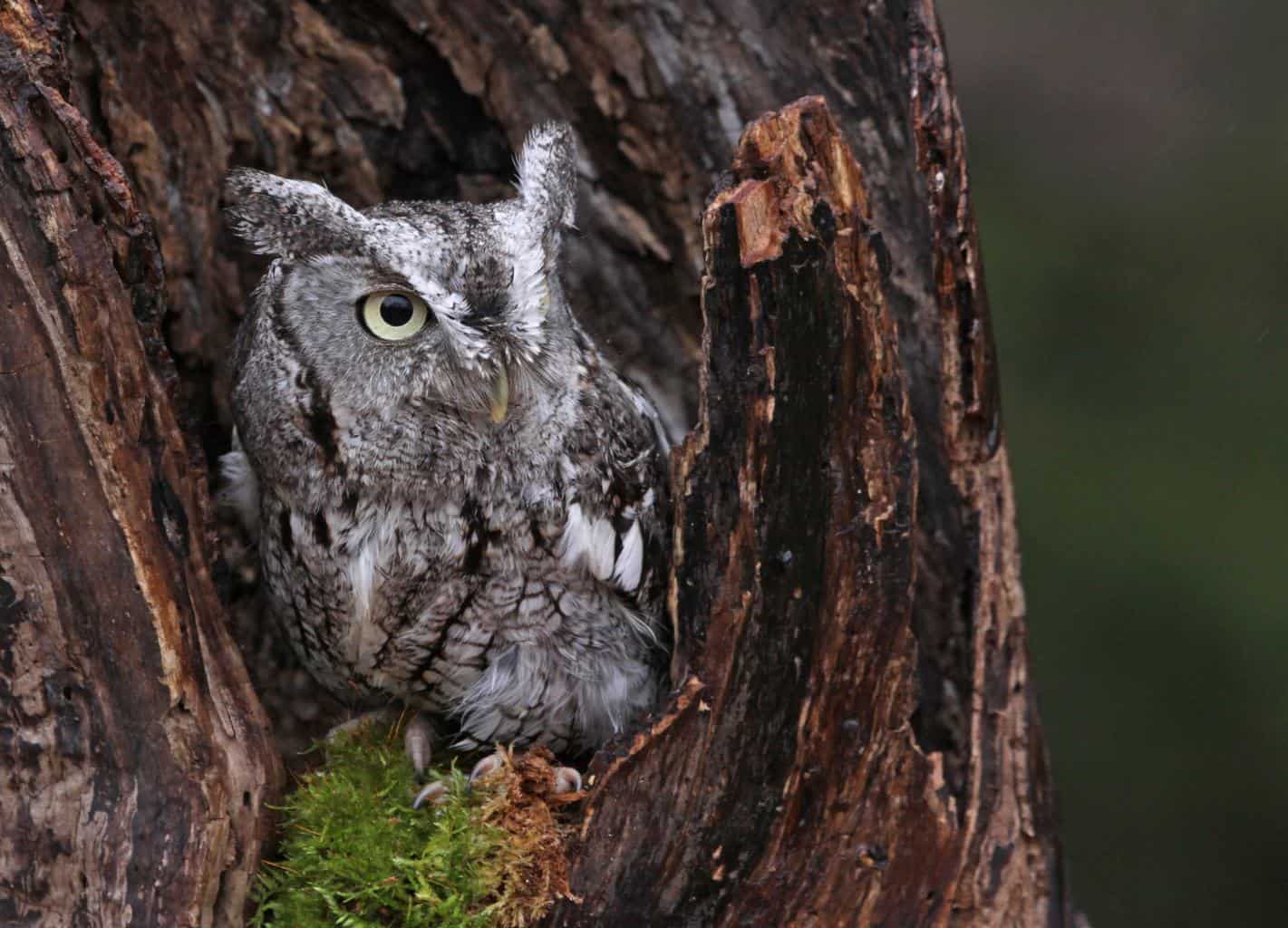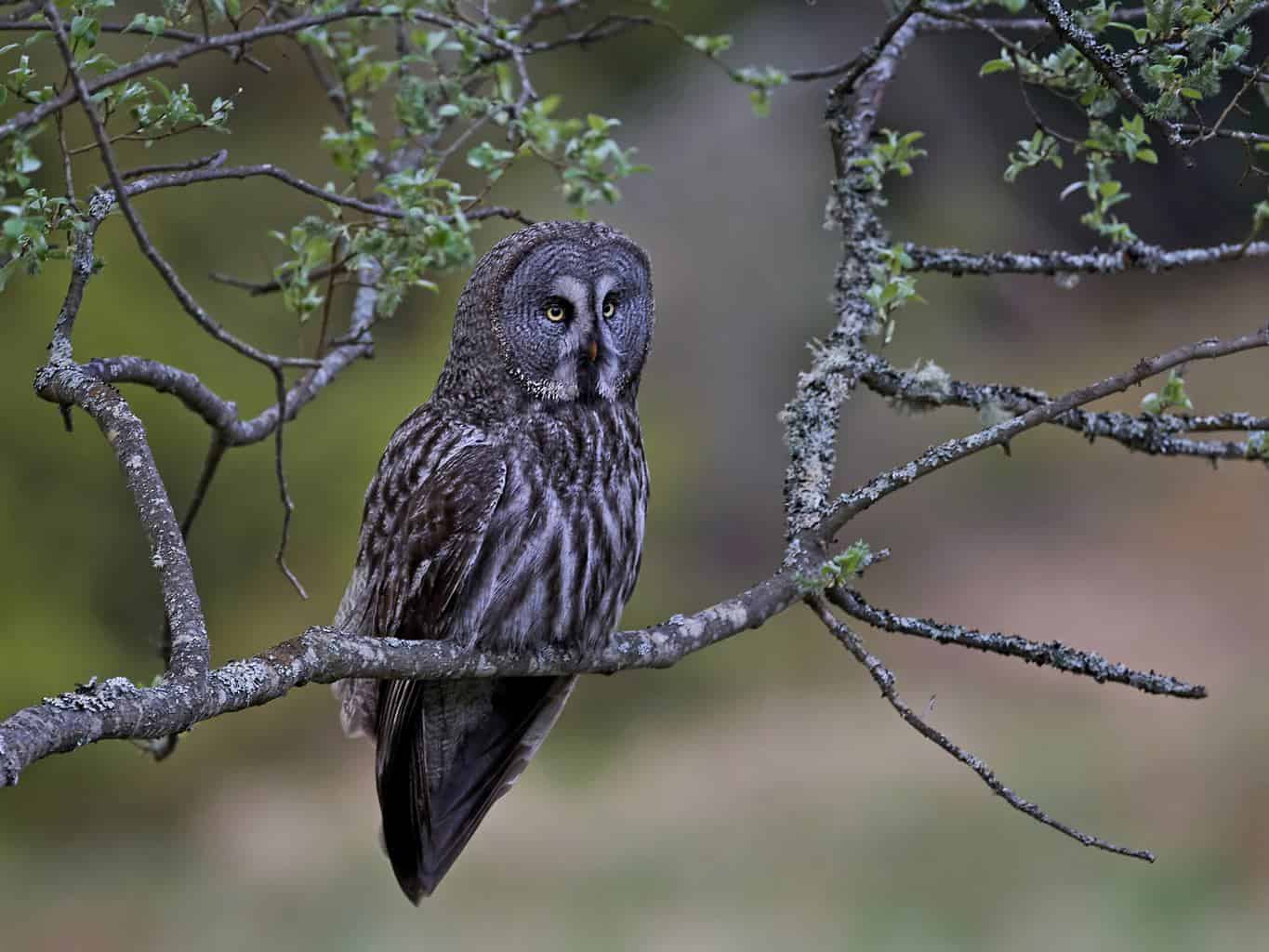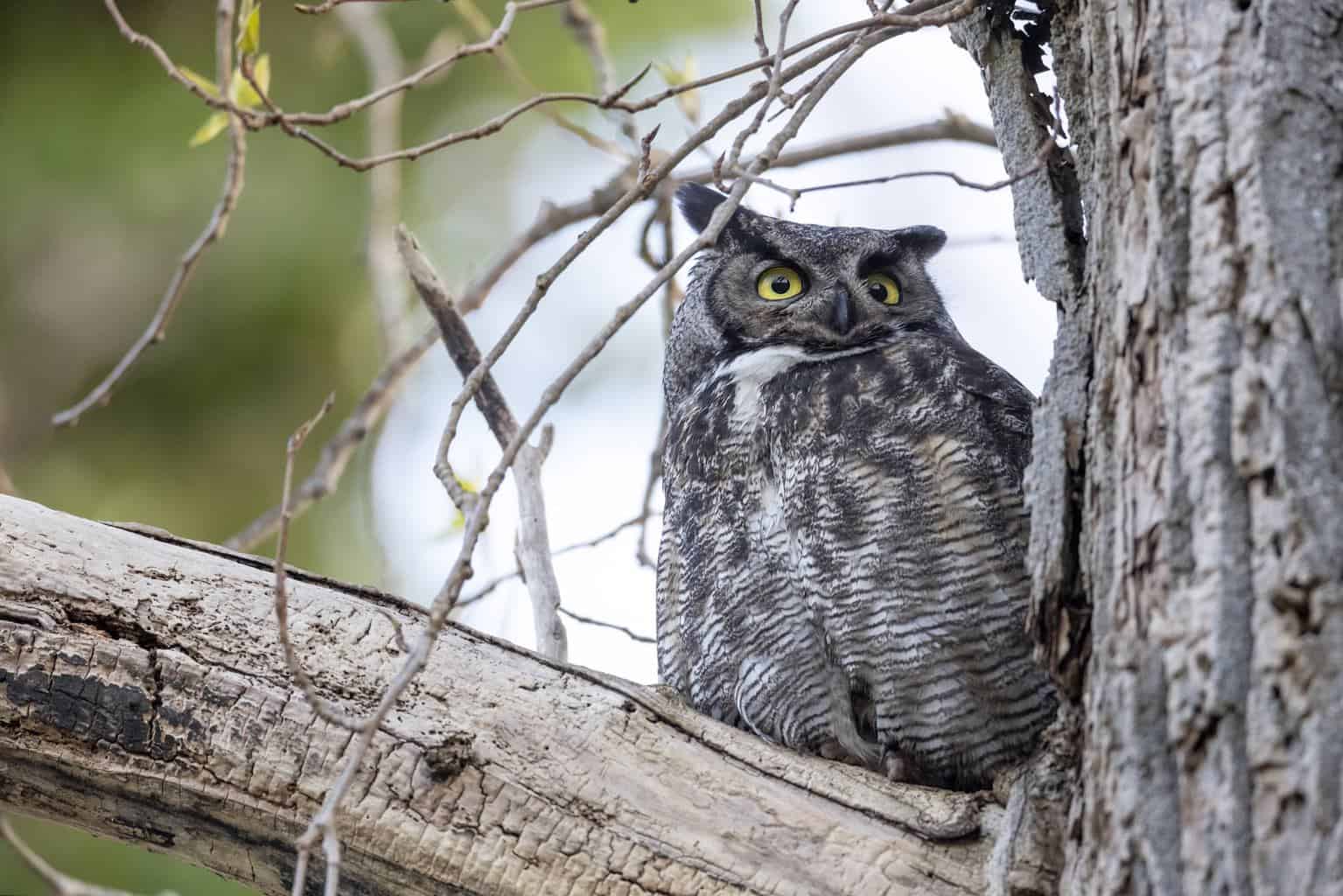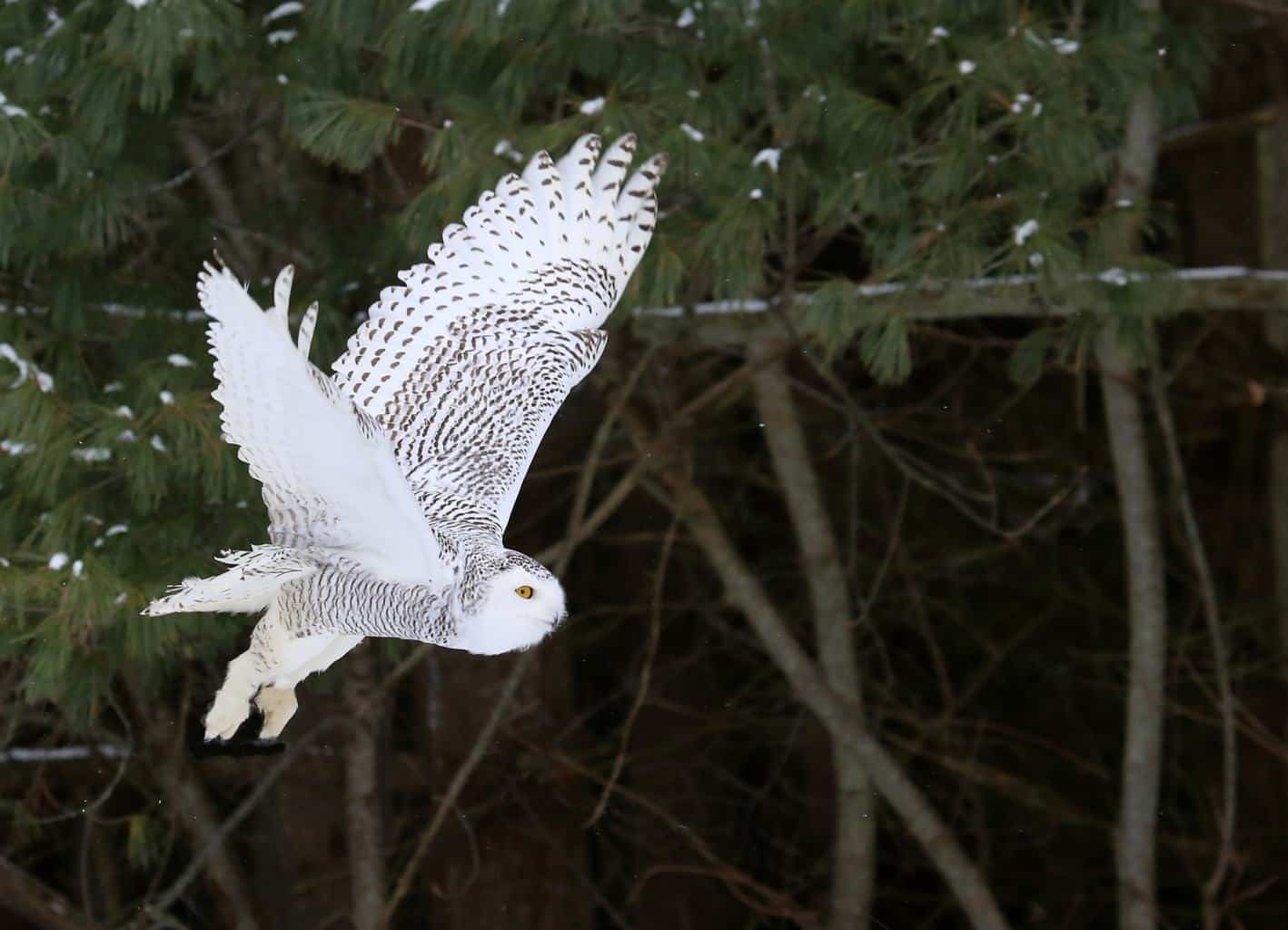According to the New Hampshire Fish and Game Department, the Granite State is home to over 300 species of birds, including 186 that regularly breed within the state borders.
Given that New Hampshire is one of the smallest states in the United States, that’s pretty impressive! What’s even more impressive is that the state houses 12 different owl species.
In today’s article, we’ll briefly walk you through the owls in New Hampshire. Let’s hop right in!
Eastern Screech-Owl

- Scientific Name: Megascops asio
- Length: 6.3-9.8 inches
- Weight: 4.3-8.6 ounces
- Wingspan: 18.9-24.0 inches
First up on our list is a species that’s one of the state’s most iconic birds, despite its small size. The popular eastern screech-owl exists in two varieties: the rufous (mostly reddish-brown feathers) and the grey morph, which is obviously mostly grey.
These owls have a variety of markings and patterns that give them the perfect camouflage, and even though they’re strictly nocturnal birds, they’re highly adapted to live around urban and suburban areas.
One of the birds’ most characteristic features is its earlike tufts of feathers with ears below them. They use them for communication and to threaten competitors.
Great Grey Owl

- Scientific Name: Strix nebulosa
- Length: 24.0-33.1 inches
- Weight: 24.7-60.0 ounces
- Wingspan: 53.9-60.2 inches
Great grey owls are one of New Hampshire’s most notable owls. They’re one of the most heavily feathered owls, making them look quite huge when compared to other owls in the state.
As you can tell from their length measurements, they’re extremely tall thanks to their tails, and their large facial disks make the birds easy to identify. However, what really makes them stand out are the bowtie-shaped white markings across their necks.
Combine these traits with their yellow-colored eyes and the pale X-shaped cross arc on their faces, and you get a bird that’s both glorious and intimidating!
American Barn Owl

- Scientific Name: Tyto alba
- Length: 12.6-15.8 inches
- Weight: 14.1-24.7 ounces
- Wingspan: 39.4-49.2 inches
While, for the sake of keeping this article easy to understand, we’ll solely be referring to this species as the American barn owl, note that this bird goes by many names, including ghost owl, church owl, or monkey-faced owl.
The bird is medium-sized and sports long and rounded wings, long legs, and smooth and pale faces that have no ear tufts.
American barn owls are some of the most easily identified birds in New Hampshire because they don’t look anything like other owl species. Unfortunately, you’ll only see them hunting open fields at night because they’re strictly nocturnal birds. They make their homes in tree cavities and old barns, just as you probably guessed by the species’ name.
Great Horned Owl

- Scientific Name: Bubo virginianus
- Length: 18.1-24.8 inches
- Weight: 32.1-88.2 ounces
- Wingspan: 39.8-57.1 inches
Great horned owls are among the most iconic species of owls in North America. They have a characteristic orange face with contrasting black and white lines that give the impression of a tiger’s stripes, which is why these birds are also known as the tiger owl.
The horn-like tufts that add to their dangerous predator persona give this species its name, but the birds’ striking eyes can’t be overlooked either.
Great horned owls are New Hampshire’s major nocturnal raptors, hunting anything from small mice to large squirrels. They’re well-adapted to live alongside humans, so it’s easy to spot them in and out of forests and parks.
Barred Owl

- Scientific Name: Strix varias
- Length: 16.9-19.7 inches
- Weight: 16.6-37.0 ounces
- Wingspan: 39.0-43.3 inches
Barred owls are common in New Hampshire as well as other eastern states and Canada.
Their most distinguishable feature is their heart-shaped facial disk that resembles that of the barn owl and reddish-brown body markings that look a lot like those the great horned owl sports.
You can also easily identify the barred owls by their horizontal stripes that alternate dark and light hues of brown, which cover their tails, backs, and wings.
Snowy Owl

- Scientific Name: Bubo scandiacus
- Length: 20.5-27.9 inches
- Weight: 56.4-104.1 ounces
- Wingspan: 49.6-57.1 inches
Snowy owls are relatively large birds with thick feathering, round heads, and no earlike tufts of feathers. The most characteristic features of birds of this species are their mostly white feathers and sharp yellow eyes. Some may have a few black markings or mottling.
Snowy owls typically perch on fence posts and telephone poles and have a relatively tolerant temper around humans.
Burrowing Owl

- Scientific Name: Athene cunicularia
- Length: 7.5-9.8 inches
- Weight: 5.3 ounces
- Wingspan: 21.6 inches
Burrowing owls are among the few owls that aren’t nocturnal predators, as they’re most active during day hours. This is good news for avid birders; your chances of seeing a burrowing owl while you’re out for a mid-afternoon hike are pretty high.
You’ll mainly find this species spending time in the western United States, however, some have reported sightings of them in New Hampshire. If you’re lucky, you might see one, too!
They’re characterized by their mottled brown color and deep yellow eyes, but their short tails, long legs, and round tuft-free heads are also distinguishing features of the owls.
Long-Eared Owl

- Scientific Name: Asio otus
- Length: 13.8-15.8 inches
- Weight: 7.8-15.3 ounces
- Wingspan: 35.4-39.4 inches
As the long-eared owl’s name suggests, these owls are characterized by their remarkably long tufts of feathers that look like ears.
The medium-sized birds have oval heads and distinct yellow facial disks, and they’re marked by a white “X” between their eyes.
This species is fun to look at, but you don’t want to get into a staring contest with the long-eared owl. Birds of this species are known for their extremely large eyes that always seem surprised — it’s not likely they’ll blink first!
Short-Eared Owl

- Scientific Name: Asio flammeus
- Length: 13.4-16.9 inches
- Weight: 7.3-16.8 ounces
- Wingspan: 33.5-40.5 inches
Both long and short-eared owls bear striking similarities, which makes sense, given the fact that they carry nearly the same name.
Owls of both species are medium-sized birds with rounded heads, except short-eared owls have ear tufts that are so much shorter that they’re practically invisible.
The short-eared birds also have brown backs with white and beige mottling on the upper parts, as well as a whitish face, yellow eyes, and dark accents on the edges of their feathers.
Northern Saw-Whet Owl

- Scientific Name: Aegolius acadicus
- Length: 7.1-8.3 inches
- Weight: 2.3-5.3 ounces
- Wingspan: 16.5-18.9 inches
The smallest owl in New Hampshire and the entire eastern United States region is the northern saw-whet owl. The tiny and elusive bird is known for its relatively loud call. Follow the sound of its cries to its preferred habitat: dense foliage.
Note this species’ small brown feathered bodies and comparatively large heads. Their faces are mottled with black spots but are mostly covered in white feathers with an undefined facial disk.
Boreal Owl

- Scientific Name: Aegolius funereus
- Length: 8.3-11.0 inches
- Weight: 3.3-7.6 ounces
- Wingspan: 21.6-24.4 inches
Unlike the other species of owls on this list, boreal owls aren’t commonly found in New Hampshire. In fact, they’re quite a rare find in the United States’ northeastern region. However, they’re occasional winter visitors to the state, so if you find yourself there during the colder months of the year and have a bit of luck on your side, you just might spot one of them.
These birds are cute and small with relatively big heads and small ear tufts. Their most easily recognizable features, however, are the tiny white dots across the birds’ facial disks.
Northern Hawk-Owl

- Scientific Name: Surnia ulula
- Length: 14.2-17.7 inches
- Weight: 8.5-16.0 ounces
- Wingspan: 27.9 inches
Last but certainly not least is the northern hawk-owl. The medium-sized bird has an oval-shaped body and a long, pointed tail.
Much like the burrowing owl mentioned above, this species is mainly active during the day but will occasionally get out at night. You’ll mostly find them near marshes and in open coniferous forests.
Wrap Up
And there you have it — the 12 species of owls you’ll find in New Hampshire! As you can see, the small state packs a punch when it comes to owls, so make sure you can check them out while you’re there!

